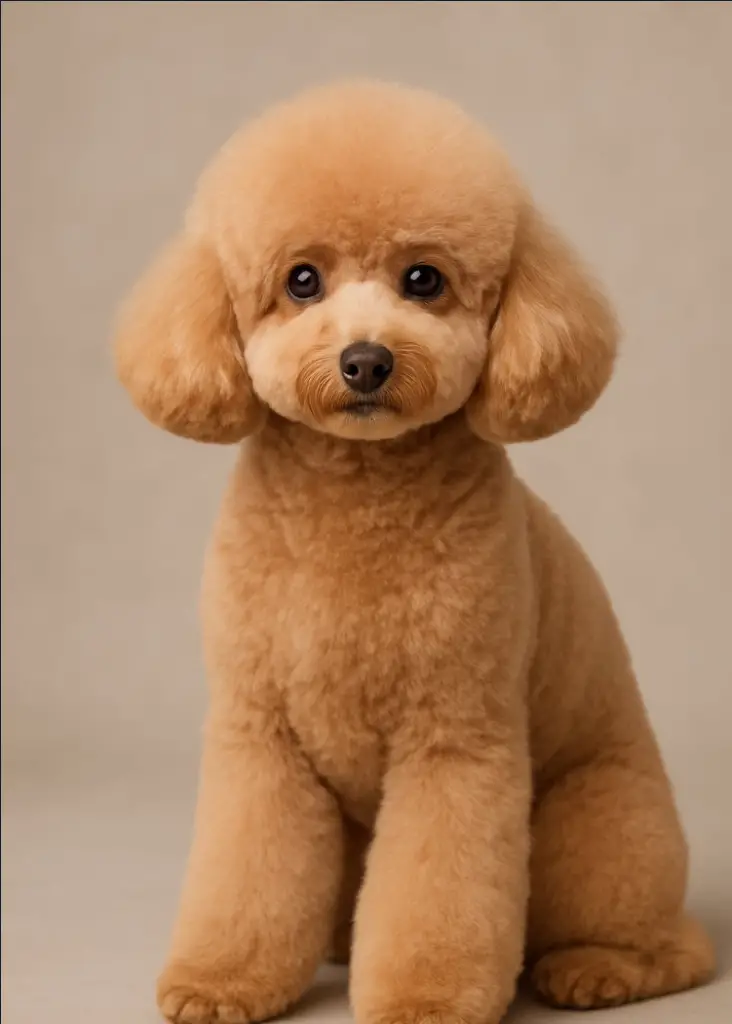
French poodles have unique coats that require special grooming to keep them looking their best. Their hair grows differently from other dogs, so picking the right grooming style can help maintain comfort and appearance.

Choosing the right grooming style helps highlight the French poodle’s personality while keeping their coat healthy and neat. Grooming can be a simple task or a creative way to show off the poodle’s charm, depending on the owner’s needs and preferences.
1) Classic French Clip with Pompons

This style highlights the poodle’s natural shape while adding decorative pompons on the legs and tail. The body is clipped short, leaving rounded puffs of fur at key points for a neat look.
It requires regular grooming to keep the pompons well-shaped and the coat clean. This cut is both stylish and practical for many poodles.
2) Teddy Bear Cut for Soft Texture

The Teddy Bear Cut gives French Poodles a soft and rounded look. It focuses on trimming the hair evenly across the body and shaping the face to create a plush, cuddly appearance.
This style works best for dogs with curly or wavy coats. Regular grooming is needed to keep the texture soft and the shape neat.
The cut is practical and makes the poodle look approachable without the sharp lines found in traditional show styles.
3) Puppy Cut with Uniform Length

The Puppy Cut is a simple style where the hair is trimmed to the same length all over the body. It usually stays around half an inch to one inch long.
This cut gives the poodle a soft and fluffy look, similar to a young puppy’s coat. It is easy to maintain and keeps the dog comfortable.
This style works well for owners new to grooming because it is quick to do and does not need special shaping. It suits most poodle sizes and ages.
4) Lamb Cut for Easy Maintenance

The Lamb Cut is popular for its easy care and neat look. It involves trimming the poodle’s coat evenly, usually leaving the hair slightly longer than some other cuts.
This style works well for owners who prefer to groom their dogs at home. It also helps prevent matting while keeping the coat soft and manageable. The length can be adjusted to suit different climates or personal preferences.
5) Continental Clip with Full Mane

The Continental Clip with Full Mane is a classic grooming style for French Poodles. It keeps the pom-poms on the legs, tail, and chest, while leaving a full, thick mane around the neck.
This look adds a strong, elegant appearance. The mane is left longer to create a fuller silhouette. It requires regular trimming to keep the shape neat.
This style is often chosen for show dogs or owners who want a traditional and stylish look. It highlights the poodle’s unique coat texture well.
6) Top Knot and Braided Accents

The top knot is a classic grooming style for French Poodles. It gathers the hair on the head into a neat bundle, keeping it tidy and stylish.
Adding braided accents along with the top knot gives a unique, decorative look. Braids can be simple or intricate, depending on the groomer’s skill.
This style works well for poodles with longer hair. It requires regular brushing and careful trimming to maintain clean lines and prevent tangles.
7) Natural Curly Look with Trimmed Feet

This style highlights the poodle’s natural curls while keeping the feet neatly trimmed. It offers a clean and tidy appearance without losing the dog’s curly texture.
Regular trimming of the feet helps prevent matting and keeps the paws comfortable. The rest of the coat is left longer and shaped to maintain softness and bounce.
This look is low to moderate in maintenance and suits owners who want a natural style but still need practical grooming.
Understanding Coat Types and Texture

The French Poodle’s coat can vary widely, affecting grooming methods and maintenance frequency. Knowing the differences in coat types and how texture changes care routines helps owners choose the best grooming style.
Curly vs. Corded Poodle Coats
French Poodles most often have curly coats with tight, springy curls through their body. These curls trap dirt but need frequent brushing to avoid mats and tangles. Regular grooming every 6-8 weeks is common to keep the coat neat and manageable.
Corded coats are less common. Instead of loose curls, the hair forms long, rope-like “cords” that hang down. These cords require specialized care to prevent matting and keep them clean. Owners must separate cords by hand regularly to maintain the look and avoid painful mats.
Both coat types require different tools: brushes for curly coats and gentle separation for cords. Each style demands patience and commitment to proper upkeep.
How Coat Texture Influences Grooming Choices
Coat texture directly shapes grooming routines. Curly coats need daily brushing with a slicker brush and combs designed to reach the undercoat. Without proper brushing, the hair mats easily, causing discomfort.
Corded coats eliminate regular brushing but need manual cord separation and occasional trimming. Bathing must be thorough, and drying can take longer because cords hold water.
Wavy or softer textures, which some French Poodles may have, lie between curly and corded styles. They usually require less frequent brushing than curly coats but still benefit from regular grooming.
Choosing a grooming style depends on the coat texture to balance maintenance time and the dog’s comfort.
Caring for Groomed French Poodles

Proper care keeps a French Poodle’s coat clean, healthy, and looking sharp. Regular brushing and attention to common coat issues help maintain their groomed style and prevent discomfort.
Routine Maintenance Tips
Daily brushing is crucial. It prevents tangles and removes loose hair. Use a slicker brush or comb designed for curly coats. Focus on areas prone to knots, like behind the ears and under the legs.
Regular baths every 3 to 6 weeks help keep the coat clean. Use a mild, poodle-safe shampoo and conditioner to avoid drying out the skin. After bathing, dry thoroughly with a towel or low heat dryer.
Trimming around the face, ears, and paws must be done every few weeks to keep the dog neat. Nails should be clipped regularly to avoid overgrowth and discomfort. Also, check and clean ears weekly to prevent infections.
Managing Matting and Shedding
French Poodles don’t shed much, but their curly coat easily mats if not cared for. Mats start small and can tighten painfully, hiding skin irritations underneath.
To manage mats, use a detangling spray and gently work through knots with fingers or a comb. For tough mats, a professional groomer or clipping might be necessary.
Shedding is minimal but still present. Frequent brushing helps capture loose hair before it forms mats. Keeping the coat brushed also evenly spreads natural oils, making the fur healthy and shiny.
